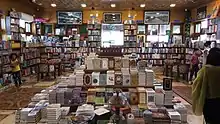Media in Jammu and Kashmir
Media in Jammu and Kashmir (JK) consists of media houses such as Greater Kashmir and Rising Kashmir, Daily Excelsior and radio stations such as AIR Srinagar, AIR Jammu, Radio Mirchi 98.3 FM,[1] Red FM 93.5[2] and Radio Sharda. DD Kashir is state television broadcaster. Major private channels are News18 Urdu and Gulistan News.[3] Various books have been written about the region, a large number being related to the Literature of Kashmir, Culture of Kashmir, Lal Ded[4] and Nund Rishi. Koshur, Dogri, Punjabi, Pahari, Gojri, Hindi-Urdu and English are the main languages used.[5][6]
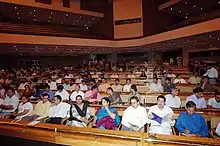
Periodicals
Major periodicals in Jammu and Kashmir include Greater Kashmir, Rising Kashmir, Kashmir Times, Daily Excelsior, Elite Kashmir and Kashmir Monitor.[6]
News Agencies of Kashmir
Kashmir News Bureau (KNB), Current News Service(CNS), KNS[7] and Asian News International.[8] A Press Council of India report in 2017 titled "Media and Media Scenario of J&K" in 2017 stated that newspapers and periodical approved by the government of Jammu and Kashmir in which government-sponsored advertisements are released is 467, with 146 of them being on the DAVP panel.[9]
Cinema and music
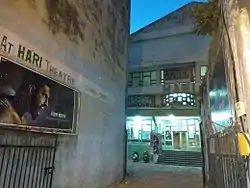
Kashmiri cinema and Dogri cinema are major film and music industries in Jammu and Kashmir.[10] Music companies like Music Tape Industry (MTI) Studios, Jammu and Kashmir Academy of Art, Culture and Languages (JKAACL) and T-Series Kashmiri Music [11][12] promote traditional Kashmiri folk music like Chakri, Henzae, Wanvun, Ladishah, Bacha Nagma, Dumhal, Dogri Bhakh, Gojri music[13] and top singers like Raj Begum, Vibha Saraf, Qazi Touqeer, Shameem Dev Azad, Nargis Khatoon[14][15] Bushra & Uzma (twins),[16] Mehmeet Syed,[17] Sakeena Reshi,[18] Pragaash, Shabnam Naz,[19] Shameema Akhtar,[20] Sheela Zargar, Shazia Bashir,[21] Zahida Taranum,[22] MC Kash. During the Kashmir conflict following 1989, cinema halls were closed. Kashmiri militants said that films in movie halls were "un-islamic" while the Indian Army used movie halls as garrisons. In 1999 attempts were made to reopen the movie halls, but after a series of attacks, soon they were shut again. The movie hall "Neelam" has been used by the CRPF till as recent as July 2018.[23] During the "Kashmir World Film Festival" in 2017, Naeem Akhtar, a Kashmiri politician, talked about reopening of the cinema halls.[24] Kashmir's first multiplex is under construction as of June 2020[25] while Jammu division has multiple multiplexes. Several multiplex cinemas are:
Radio

Radio stations in Jammu and Kashmir include "AIR Srinagar", "AIR Jammu" and "Radio Sharda".[34] Radio Jammu Kashmir was the first broadcasting centre of Jammu and Kashmir, coming into existence on 1 December 1947.[35] Radio Sharda, a worldwide community radio service for Kashmiri Pandits, was started by Ramesh Hangloo.[36] FM Tadka 95.0, BIG FM 92.7, Radio Mirchi and Red FM 93.5 are private FM radio stations in Jammu city[37][38] and Srinagar.[39][40]
Television
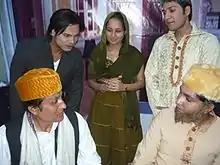
DD Kashir is major television channel of J&K UT. Most watched kashmiri programme was Kus Bani Koshur Karorpaet.[41][42] Popular private television channels are News18 Urdu and Gulistan News.[43]
Books
.jpg.webp)
Writers produce books "documenting everything (in Jammu and Kashmir) from folklore to political happenings, to the sufferings of people". A number of young writers are seen.[47] Yayavar is annual Literary Festival of Jammu Division.[48] Gulshan Books is the only bookshop-library on a lake in Jammu and Kashmir.[49] Famous dogri writers are Jitendra Udhampuri and Champa Sharma while kashmiri writers are Mahjoor, Zareef Ahmad Zareef, Amin Kamil, Ghulam Nabi Gowhar, Shahnaz Bashir, Ghulam Rasool Nazki, Z. G. Muhammad and Ghulam Nabi Firaq.
List of news media in Jammu and Kashmir
- The Kashmiriyat
- Kashmir Bylines
- JK Newsline
- Al Hind Global Press Media
- Kashmir Life
- Kashmir News Bureau
- Koshur Akhbar
- Soan Meeraas
- State Times
- The Kashmir Walla
- The Straight Line
- Sachnews Jammu Kashmir
- KNO- Kashmir
- Journal News Asia [JNA]
- JK Media
- Global News Service - Kashmir
- Kashmir News Observer
- Khalsa Express
- JK Update
- Daily Taskeen
- The Bold Voice
- The Chenab Times
- Lazawal
- Sada e Kohistan
- Kashmir Glory
- Kashmir Monitor
- Infobug Infotainment Channel
- JK Free Spirit Media
- Daily Azaan e Saher
Newspapers
- Greater Kashmir
- Rising Kashmir
- Daily Excelsior
- State Times
- Kashmir Reader
- Free Press Kashmir
- Kashmir Times
- The Kashmir Monitor
- Kashmir Sports Watch
- State Observer
- The Kashmir Scenario
- The Himalayan Mail
- Kashmir Uzma
- Daily Udaan
Magazine
- Badalta Manzar[50]
- Asnaav[51]
- Shiraza Dogri
Television
- Gulistaan News
- DD Kashir
- News18 Urdu
- DD Urdu
- Zee Salaam
Media issues in Jammu and Kashmir
19 journalists have been killed in Jammu and Kashmir since 1990.[52] The region has seen various prohibitive measures against the media.[53][54]
Media coverage of the Kashmir conflict
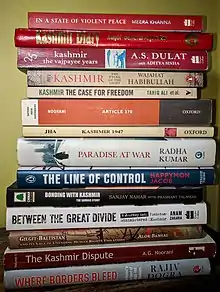
A study by Chindu Sreedharan concluded the dominance of "anti-peace news" in the overall coverage of Kashmir suggesting that the press in India and Pakistan has a counterproductive role in the Kashmir issue and that the "coverage was vigorously government-led and intensely 'negative'".[55][56] A study in the Pakistan Journal of History and Culture found that newspapers of both countries (India and Pakistan) were "setting the agenda on Kashmir issue positively in the light of foreign policy of their respective country".[57]
A Reuters Institute Fellowship paper titled "Media Propaganda and the Kashmir Dispute: A Case Study of the Kashmir Floods" based on an analysis of the New Delhi-based media’s coverage of the 2014 floods in Kashmir, the study concludes that "its reporting was biased and subjective". Almost all the coverage focused on the rescue efforts of the Indian armed forces. while the contribution made by local volunteers in providing relief was. The paper established that The Times of India devoted 57% of its coverage "specifically to the army’s relief efforts" while NDTV focused 97% of its content "on the army and government’s role in the crisis".[58]
Attacks on journalists in the Kashmir conflict
Since 1990, the total number of journalists who have been killed in Jammu and Kashmir is 19.[52]
The first major killing in Jammu and Kashmir by militants was of Lassa Kaul, the Director of Srinagar Doordarshan in February 1990, outside his house in Bemina.[59][60] This was followed by the killing of P.N. Handoo of the State Information Department. Militant and terrorist groups also "imposed a ban on the distribution of national newspapers and Kashmir Times and Daily Excelsior, both published in English from Jammu".[61][62] Ghulam Muhammad Lone and his eight year old son were killed in 1994 by gunmen.[63] On 10 August 2000, a grenade killed seven journalists including Pradeep Bhatia, a journalist from Hindustan Times.[64] Asiya Jeelani, a print reporter, died after a van in a landmine blast in Kupwara.[65] The most recent killing of a journalist, Shujaat Bukhari, happened in June 2018.[66]
The counter the Pakistani misinformation campaign the central government allocated Rs 430 crore for upgrading and improving Doordarshan and All India Radio for Jammu and Kashmir in 2004.[6]
Media censorship
In 2016, newspaper publications were banned for three days in Kashmir.[54]
On 24 August 2017, the Ministry of Electronics and Information Technology sent a letter to Twitter under Section 69A of the IT Act to censor content. Following this Twitter users received official legal complaints from Twitter.[67]
A Press Council of India report in 2017 titled "Media and Media Scenario of J&K" in 2017 states that “journalists in Kashmir have to manage the reality of walking on the tightrope amidst the threats of gun and political arm-twisting”.[9] Security forces consider photojournalists as "instigating protestors", while the protestors call them "government agents".[53]
Laxmi Murthy and Geeta Seshu of Network of Women in Media, India (NWMI), in their 2019 report titled, 'News behind the barbed wire", based on field observation after the abrogation of Article 370 of the Indian Constitution, which provided special status to the erstwhile state of J&K, expressed that, "in the absence of reportage from the ground, the government’s influence of the narrative of normalcy is near total. Its official proclamations of the creation of a ‘Naya Kashmir’ have become vociferous. In contrast, there is a deafening silence and invisibilisation of voices from Kashmir expressing alienation, anger and disillusionment at perceived breach of trust. The government’s control of communication processes is intrinsically undemocratic and harmful, as it privileges the voices of authority and weakens those who speak truth to power." [68]
The Media Policy 2020 of the Jammu and Kashmir has also been criticised for allegedly "monopolising the flow of information by the state".[69] Press Council of India was particularly alarmed by the provisions of 'fake news' in the media policy, which it said, while taking suo-moto cognisance of the matter, "interferes with the free functioning of the press." [70]
Arrest of journalists
Kamran Yusuf, a freelance Kashmiri photojournalist, was arrested by the National Investigation Agency (NIA) on 5 September 2017 and was released on bail on 14 March 2018. During this time, he was lodged in the Tihar Jail, New Delhi.[71][72] The bail petition was opposed by the NIA.[73] In an earlier case, Dawn reported that on 19 August 2011, Showkat Shafi, a freelance photojournalist was "beaten by government forces" and then taken to the nearest police station. After his release, he had to be hospitalised.[74]
See also
References
- "FM: Mirchi 98.3 starts operations in Srinagar". The Times of India. 2018-06-18. Retrieved 2020-08-23.
- "Eid-ul-Azha: Red FM launches station in Srinagar". United News of India. 2020-08-23. Retrieved 2020-08-23.
- Hamid, Peerzada Arshad (2017-03-21). "Kashmiris living outside post messages on TV to connect with isolated families". Xinhua. Retrieved 2020-08-22.
- "Lalla Ded – The Epitome of Kashmiriyat". Kashmir Images Newspaper. 2020-10-05. Retrieved 2020-10-05.
- "Declare Gojri and Pahari as official J&K languages: JKAP leader". Kashmir Images Newspaper. 2020-09-07. Retrieved 2020-09-07.
- Communication, Compiled & Edited by Research, Reference and Training Division-National Documentation Centre on Mass Communication (2016). Mass Media in India - 2004. Publications Division, Ministry of Information & Broadcasting. ISBN 9788123023380.
- KNS (2020-08-24). "Kashmir News Service provides the most latest coverage and up to date news, breaking news,feature stories, videos, information on Kashmir,politics, cricket and more". Kashmir News Service. Retrieved 2020-08-24.
- "Asia's Premier News Agency - Kashmir News, Business & Political, Bollywood, Sports". ANI News. Retrieved 2020-08-22.
- Maqbool, Majid (15 October 2017). "Despite Numerous Challenges, J&K Media Is Growing, Says Press Council of India". The Wire. Archived from the original on 2 February 2019. Retrieved 2 February 2019.
- "J&K CM's wife set to launch new album". Hindustan Times. Press Trust of India. 2006-12-19. Retrieved 2020-08-24.
- "A small music label that immortalised Kashmir's music". The Kashmir Walla. 2020-07-07. Retrieved 2020-09-07.
- "T-Series on verge of becoming No. 1 YouTube Channel". Greater Kashmir. 2019-03-21. Retrieved 2020-09-07.
- https://www.dailyexcelsior.com/gojri-folk-instruments/
- Team, WION Web (2020-08-24). "Kashmir Connect: Meet a singing sensation from the valley, World News". WION. Retrieved 2020-09-07.
- "Nargis Khatoon: A New Kashmiri Singing Sensation With Celebrity Fanbase". Kashmir Observer. 2020-08-12. Retrieved 2020-09-07.
- https://risingkashmir.com/news/musical-evening-to-revive-folk-music-culture-held-on-dal-banks--331862.html
- "Female singer Mehmeet Syed popularises Kashmiri music across the world". Yahoo News India. 2018-08-26. Retrieved 2020-09-07.
- Ishfaq-ul-Hassan (2019-01-13). "Young singer Sakeena Reshi from J&K moves 1 million hearts". DNA India. Retrieved 2020-09-07.
- https://www.dailyexcelsior.com/7-emerging-female-voices-in-gojri-music/
- "Singer Shameema Akhtar comes with new song in praise of Police". Kashmir News Bureau. 2018-03-31. Retrieved 2020-09-07.
- "Stealing the Show". Rising Kashmir. 2016-04-09. Retrieved 2020-09-07.
- Northlines (2018-12-02). "Artists pay musical tributes to legendary singer Raj Begum, Rashid Farash". The Northlines. Retrieved 2020-09-07.
- Nazir, Aijaz (2 July 2018). "Kashmir loses its cinema halls to prolonged conflict". Al Jazeera. Archived from the original on 4 January 2019. Retrieved 3 January 2019.
- Shekhawat, Gazal (7 November 2017). "KWFF renews debate over reopening of cinema halls in Kashmir valley". The Indian Express. Archived from the original on 3 August 2018. Retrieved 3 February 2019.
- Malik, Saqib (2020-06-27). "Kashmir's first multiplex hits roadblocks". Greater Kashmir. Retrieved 2020-06-28.
- https://www.channel1.in/jammu-got-its-first-pvr-theatre
- https://www.deccanchronicle.com/nation/current-affairs/130320/pvr-cinemas-shut-shop-in-delhi-kerala-jammu-till-march-31.html
- https://www.livemint.com/industry/media/cinema-biz-takes-a-hit-as-releases-get-postponed-amid-shutdowns-11584035222142.html
- "Ticket price hike keeps moviegoers away in Jammu". The Tribune. 2016-08-04. Retrieved 2020-08-12.
- "Giani Ice Cream opens 1st outlet at Katra". Daily Excelsior. 2018-05-02. Retrieved 2020-08-12.
- "Wait is over: 'Geetiyaan' to hit screens tomorrow". Daily Excelsior. 2014-02-26. Retrieved 2020-08-12.
- Generator, Metatags. "Jammu Sanskriti School Kathua organised a fun filled trip to Moonlight, Cineplex at Kathua to watch a movie Bhem and The Himalayan Adventure". Universal News Timeline (UNT). Retrieved 2020-08-12.
- "Heavy vehicular traffic banned in Udhampur city". Greater Kashmir. 2015-03-14. Retrieved 2020-08-12.
- "Radio Kashmir holds function". Daily Excelsior. 2 February 2019. Retrieved 3 February 2019.
- "Website of Radio Kashmir Jammu launched". India Today. PTI. 22 July 2016. Archived from the original on 3 February 2019. Retrieved 3 February 2019.CS1 maint: others (link)
- Mohan, Archis (6 February 2016). "The borderline cases of Jammu & Kashmir". Business Standard India. Archived from the original on 8 November 2017. Retrieved 3 February 2019.
- Khajuria, Sanjay (2017-10-10). "Radio Mirchi goes 'on air' in Jammu". The Times of India. Retrieved 2020-08-30.
- "'Jammu Ka Apna Pakka Local Festival' Red FM Ka Thappa culminates". State Times. 2019-06-30. Retrieved 2020-08-30.
- Irfan, Hakeem (2018-08-20). "Rapper Badshah launches radio station in Srinagar, urges Kashmiri youth to use social media to bring change". The Economic Times. Retrieved 2020-08-30.
- "FM radio stations and their audiences bloom in restive Kashmir". Asia Times. 2018-09-25. Retrieved 2020-08-30.
- "Valley's own version of KBC creates buzz on social media". The Tribune. 2019-05-01. Retrieved 2020-08-30.
- "Kashmir gets its own version of KBC from today". The Tribune. 2019-04-29. Retrieved 2020-08-30.
- "Amid Shutdown, a Private News Channel Connects Thousands in J&K". The Wire. 2019-09-24. Retrieved 2020-08-30.
- "Books and coffee on a Kashmir island". BBC News. 2016-06-29. Retrieved 2021-01-11.
- Raina, Anil (15 January 2018). "Jammu and Kashmir: Srinagar's Gulshan Books Kashmir enters Limca Book of Records". Mumbai Mirror. Retrieved 2021-01-11.
- Bakhsh, Zenaira (2020-07-30). ""Truth over fiction": After Art-370's revocation, more Kashmiris are reading books on history than before". The Kashmir Walla. Retrieved 2021-01-11.
- Mirani, Haroon (28 December 2018). "2018: A year on my shelf". Greater Kashmir. Archived from the original on 3 February 2019. Retrieved 3 February 2019.
- "'Yayavar'- Jammu Literary Festival - Uniting readers and writers in an inspiring celebration of Literature". The Dispatch. Retrieved 2020-08-30.
- "This Kashmiri publishing house has entered Limca Book of Records. Here's why". Times Now News. 19 January 2018. Retrieved 3 February 2019.
- "Official website of weekly news magazine Badalta Manzar, which projects the rapid economic development and growth taking place in Jammu and Kashmir". Badalta Manzar. Retrieved 2020-08-31.
- "Official website of Asnaav.com an online magazine published from Kashmir". Asnaav. Retrieved 2021-01-15.
- "The Numbers Prove Kashmir Is a Highly Unsafe Place for Journalists". The Wire. The Wire Staff. 2 November 2019. Retrieved 3 February 2019.CS1 maint: others (link)
- Maqbool, Majid (2 September 2016). "Life of a Kashmiri Photojournalist: Abuse, Hostility and Taking Risks to Tell The Story". The Wire. Archived from the original on 2 February 2019. Retrieved 2 February 2019.
- Rashid, Toufiq (17 July 2016). "Kashmir newspapers raided, printing banned for 3 days to 'ensure peace'". Hindustan Times. Retrieved 3 February 2019.
- Sreedharan, C., (2009). Reporting Kashmir: an analysis of the conflict coverage in Indian and Pakistani newspapers. Doctorate Thesis (Doctorate). Bournemouth University. Archived from the original on 10 August 2017.
- "Dr Chindu Sreedharan - Bournemouth University Staff Profile Pages". Bournemouth University. Archived from the original on 26 July 2018. Retrieved 3 February 2018.
- Ali, Shahzad; Fozia, Perveen (2015). "Representation of Kashmir Issue in the Mainstream Newspapers of Pakistan and India: A Test of Media Conformity Theory" (PDF). Pakistan Journal of History and Culture. XXXVI (2): 46. Archived from the original (PDF) on 3 February 2019.
- Khalid, Wasim (August 2016). Media Propaganda and the Kashmir Dispute: A Case Study of the Kashmir Floods Retrieved 3 February 2019. Archived from the original on 3 February 2019.
- Gigoo, Siddhartha (17 January 2016). "To Die While Dreaming of Return". The Wire. Archived from the original on 6 August 2018. Retrieved 2019-02-03.
- Khosa, Aasha (16 March 2012). "A brave chronicler of Kashmir's militancy". The Hindu. ISSN 0971-751X. Retrieved 3 February 2019.
- Rai, Ajai K. (June 2000). "Conflict situations and the media: A critical look". Strategic Analysis. 24 (3): 585–601. doi:10.1080/09700160008455233. ISSN 0970-0161. S2CID 145094564.
- K. Rai, Ajai. (2000). Conflict situations and the media: A critical look. Strategic Analysis. 24. 585-601. 10.1080/09700160008455233 - via ResearchGate.
- Raina, Irfan (3 May 2017). "World Press Freedom Day: When a reporter upheld truth at the cost of his life". Greater Kashmir. Archived from the original on 3 February 2019. Retrieved 3 February 2019.
- "Pradeep Bhatia". Committee to Protect Journalists. 10 August 2000. Retrieved 3 February 2019.
- "Asiya Jeelani". Committee to Protect Journalists. Retrieved 3 February 2019.
- "Killing of Kashmir journalist shakes India". BBC. 15 June 2018. Retrieved 3 February 2019.
- "On Centre's Request, Twitter Blocks Accounts, Tweets Over Kashmir Content". The Wire. 5 September 2017. Archived from the original on 3 February 2019. Retrieved 3 February 2019.
- https://www.newindianexpress.com/nation/2019/sep/05/media-freedom-in-valley-throttled-by-clampdown-2029118.html
- https://www.epw.in/engage/article/kashmir-media-policy-accentuating-curbs-freedom-press
- https://www.newindianexpress.com/nation/2020/jun/17/press-council-of-india-seeks-jk-govt--reply-on-fake-news-in-its-media-policy-2157594.html
- "Kashmiri photojournalist Kamran Yousuf released from Delhi Jail". Greater Kashmir. 14 March 2018. Archived from the original on 19 June 2018. Retrieved 3 February 2019.
- "India releases photojournalist Kamran Yousuf on bail". Committee to Protect Journalists. 13 March 2018. Retrieved 3 February 2019.
- "Court grants bail to Kashmiri photojournalist". Business Standard India. IANS. 3 December 2018. Retrieved 3 February 2019.CS1 maint: others (link)
- Shah, Fahad (24 August 2011). "The fate of journalism in Kashmir". DAWN. Archived from the original on 28 August 2018. Retrieved 2 February 2019.
Further reading
- Viswam, Deepa (2010), Role of Media in Kashmir Crisis, Kalpaz Publications, ISBN 9788178358628
- Showkat, Nayeem (2017), "Kashmir in media: An overview", International Journal of Advanced Research and Development. ISSN 2455-4030
- Arora, V P S & Singh, Manoj Kumar. The role of media in promoting human rights a comparative study of Jammu Kashmir and Chhattisgarh. Archived from the original on 3 February 2018.
- Sreedharan, Chindu (March 2009). Reporting Kashmir: An analysis of the conflict coverage in Indian and Pakistani newspapers, Bournemouth University thesis submission, archived from the original on 10 August 2017.
